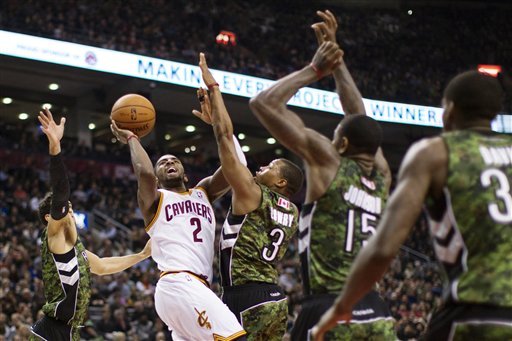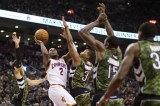So…Landry Fields for 3 years and $19M.
My initial reaction is that, in annual terms, it’s an overpay. But obviously, there are a lot of specific and extenuating circumstances surrounding the signing, and that complicates the analysis.
Further complicating the analysis is that I keep finding conflicting defensive metrics when trying to see if Fields’ defense via the eye test (he seems to be a decent man defender and even better as a team defender thanks to his high hoops-IQ and effort level) matches his numbers (it does for Adjusted +/-, but the limited Synergy Sports data I could access rates him poorly on a per-play basis).
So, with many factors affecting the analysis in all directions, let’s take a look, point by point, at the different aspects surrounding this deal.
These Contracts Are Bad
I’m not actually going to do this, but if you were to take all of the contracts in the NBA over the past decade, rank them highest to lowest in terms of yearly salary, and then chart some metric like WPA/$ or EWA/$ my guess is that you’d see a U-ish shape, whereby the best value comes at either end of the x-axis. That is, your best value is going to be with small (rookie, usually) contracts, or max contracts (with some exceptions, obviously). As Henry Abbott (and many others) have pointed out recently, it’s deals that are greater than the Mid-Level Exception (~$5M) and less than the near-max (say ~$14M) that tend to have the worst returns on a per-dollar basis. Thus, at $6.3M/yr, Fields comfortably falls in this danger zone of overpayment.
But, again, this is in the aggregate, and we can’t necessarily tag Fields as a bad deal just because others like him have underperformed similar deals.
This Contract, in Particular
$6.3M/yr is a big figure, but the risk is mitigated partially by avoiding a fourth year on the deal. Three years is an eternity in NBA terms, though, so it’s not a no- or even low-risk proposition. It’s tough to tell, based on varying metrics, if Fields is worth the money, but if we assume the generally accepted $2.5M cost per win, we would need Fields to produce approximately 2.5 wins above replacement per season to justify the cost. Based on Basketball Reference’s Win Share metric, Fields was worth 5.3 and 3.4 wins the past two years, while Hollinger’s EWA sees him as 3.4 and 1.2. I prefer BR’s method here because it includes some measure of defense (offensive and defensive rating are included), while Hollinger’s is purely offense.
So, even if Fields performed at his sophomore level (2011-12), which was well below his rookie baseline, he’d be “earning” his contract strictly in terms of $/win. This assumes he could maintain 30MPG on this roster, that he’d remain relatively healthy, and a few other assumptions, but since most seem to think The Real Landry Fields is somewhere between 2010-11 and 2011-12, a reasonable expectation might be a 4-win player.
Fields on the Raptors
Some have suggested that the large drop in Fields’ numbers last year were due to the shift in Knicks offensive philosophy from a D’Antoni-style, PG-oriented, pick-and-roll offense to an iso-heavy one with Carmelo Anthony eating up possessions like Boris Diaw at a wine-and-cheese event. This, people say, explains his precipitous drop in three-point shooting from 39% to 25%. After all, the Knicks had the 9th-lowest percentage of field goals assisted on in the NBA last year, so it’s possible that even though Fields’ usage rate increased, he had easy shots created for him far less often. This could be a criticism, but if we expect Jose Calderon or Steve Nash to be at the helm, it’s not really a big deal as Toronto and Phoenix were both top-11 in team assist rate.
But does the narrative make sense? After all, Steve Novak went gangbusters from downtown with Jeremy Lin at the helm. At the same time, the Knicks as a team fell from a 37% 3FG team to a 34% one, so maybe there’s something to it (or maybe they just lost three point shooters?). From an Xs and Os standpoint, a more motion-oriented offense should create more open opportunities by forcing defenses to rotate more, thus creating more open looks on the perimeter. However, an iso-heavy offense, if it involves good players, should force double-teams and open up drive-and-kick opportunities (for example, Atlanta was a top-5 3FG team in 2010-11’s ISO-Joe offense). In general, I’d say three point shooters should and will thrive more in a pick-and-roll style offense, but it’s not an extreme enough effect to explain such a huge drop in 3FG%.
What is troubling is that Fields also saw his FT% drop from 77% to 56%, seeing his TS% drop from 60% to 51%, a massive dip that, along with his dip in rebounding rate (more on that in a second), accounted for his entire PER drop from 13.5 to 12.1. Fields is probably more skilled as a shooter than his 52/26/56 (2FG%/3FG%/FT%, not FG/3FG/FT) from last year suggests, it also seems that his 2010-11 split of 56/39/77 may have been a bit of an abberation, as well. Maybe in an offense that fits him better, and with a clean bill of health, we can expect something in the 52/35/70 range, which would be acceptable for the role we expect him to play.
Defensively, Fields’ value will depend almost entirely on how well he (or DeMar) can adapt to playing the SF position. Below I’ve made a simple chart of every Raptor and their offensive and defensiver PER at each position last year, as well as (roughly) how many minutes that sample is derived from (I just multiplied 82games’s Minutes % by 3168, which is 48min x 66 games). Here we see that Fields certainly played the SF spot a fair amount, and it’s certainly possible that, at 6’7″, the Raptors have signed him as a Small Forward rather than a 2-guard. Then again, Dwayne Casey indicated his plan is to play a beefed-up DeMar at the three more, so it’s possible with those two and Terrence Ross we’ll be seeing more of a “2-wing” roster alignment rather than a typical SG-SF alignment. Regardless, here is the chart. (By the way, I could have used Off/Def rating as opponent PER isn’t necessarily a ‘fair’ way of assigning defensive value, but it’s what I went with. I also removed any samples smaller than 100 minutes, as 82Games.com has some curious position assigning in some cases.)
A final note on Fields is that he has a reputation as a strong rebounding guard. At 6’7″, much of this advantage may come from his size for the position, and it would be less of an impact at the three. To wit, his 8.5% rebound rate last year ranked 8th among all 2-guards (in his rookie year, his 11.7% rate ranked second), but would have been tied with Rasual Butler’s Corpse for 35th among small forwards. For comparison, DeMar’s 5.6% rate was 51st among shooting guards and would have been 2nd-last to just James Jones among threes. I should point out that these stats simply can’t be transferred as is, as a change in position would lead to more/different rebounding opportunities, but I just wanted to illustrate that Fields’ reputation as a strong rebounder can only be assumed if he remains a two.
So…in general, Fields is a good, not great, player, who is probably a better fit with the Raptors’ current incarnation than the Knicks’. We can be guardedly hopeful for a return to his 2010-11 numbers, though a midway point between his two seasons is more realistic, which, it turns out, would make his $6.3M/yr salary a slight value based on Win Shares.
Steve Nash Tactic
Of course, all of this analysis has assumed that the Fields signing exists in a vaccuum, which it does not. It is a guerilla tactic against the New York Knicks, or so it seems. You see, the Knicks were working on a sign-and-trade deal for Steve Nash with Phoenix, and Fields was one of the assets the Suns were hoping to get in return. By signing him, the Raptors make it impossible for the Knicks to sign-and-trade him to Phoenix (they can match the offer, but he can’t be dealt in that case), unless of course Fields backs out before signings can become official on July 11. This isn’t a silly consideration, however, as it’s possible the Suns value Fields at more than a 3yr/19M deal and could therefore entice him to agree to a sign-and-trade, either by offering more money up front (the Knicks own his Bird Rights and therefore aren’t subject to the Gilbert Arenas Provision the Raptors were, capping his year 1 and 2 earnings at the Mid Level amount), more money overall, or by offering a guaranteed fourth year, say a 4yr/28M kind of contract. It remains to be seen if Fields would do this, and by all accounts he is a “good guy,” but good guys have done worse for less (see: Walter White).
So, yes, this impedes the Knicks’ ability to sign-and-trade for Nash, leaving their cupboard of assets very bare to entice the Suns. However, like when Bosh left here and LeBron left Cleveland, the Suns may be willing to facilitate for peanuts (in this case, Iman Shumpert), since otherwise they’d lose Nash for nothing. If Nash chooses New York over Toronto, and the Suns can find an amicable, cap-friendly deal to be had, there’s nothing further the Raptors can do. They took away New York’s biggest chip though, as the deal, to work under the cap, would now need to include Toney Douglas, Shumpert, as well as someone sign-and-traded at a significant dollar amount (though potentially non-guaranteed) going back to Phoenix to make the salaries work. So it’s a smart move, but if that’s the only purpose, it’s extremely risky since the Raptors could be left holding their proverbial dick if Nash still opts for the Empire State (or Dallas).
In pure basketball terms, Fields is the type of player Nash seems to bring the most out of, but Fields alone certainly isn’t going to convince Nash to come here….if he’s coming, it’s for primarily off-court reasons.
As a Jeremy Lin Tactic??
It was suggested to me that, since J-Lin and Fields are BFFs, it’s possible this move also served the second purpose of attracting Lin in the event the Raptors miss out on Nash. I don’t buy it, but thought I should mention it.
Cap Implications
So with Fields in the fold, what happens with the cap situation? If you look at the chart below, you can see that once the rookies are signed and Fields is included, the Raptors are out of cap space. The chart shows Ross and Jonas at 120% of “rookie scale” value which is the normal signing amount, but until they are actually signed they count for 20% less than the amount shown here (and no, I didn’t do this just to add confusion). How, then, would they give Nash the 3yr/36M deal that has been reported? Well, it means they damn sure have to use the Amnesty Provision or trade Jose Calderon. If Jose is amnestied, that clears up most of the room there if Sonny Weems’ rights are renounced. Additionally, the Raptors could trade Jose to a team with cap space and merely get a trade exception, pick, or low-level salary in return. The Raptors would also have the option of renouncing the rights to Bayless and using the Amnesty Provision on Amir, thereby clearning more than $10M.
The most likely scenario seems to be an Amnesty of Jose to clear the space. While this makes me sad as someone who is a massive Calderon fan, Jose will get to move on to a winning situation based on him rumored suitors, so it’s not like he’s being sentenced to Charlotte or anything.
Ilyasova??
According to his agent (obviously an unbiased, trustworthy and reputable source…oh, wait…) the Raptors have made an undisclosed offer to Ersan Ilyasova. I don’t believe it, for several reasons. For one, the Raptors don’t have the cap space, and Ilyasova admitted he’s going to the highest bidder. Furthermore, the Raptors have more than enough power forwards on the roster, and it’s not clear if Ilyasova can play the three (see the first chart above – he played under 100 minutes there last year). While his floor-spacing and rebounding would be nice, a signing in the $8M annual range would be too cumbersome a cap situation. To bring Ilysaova, Fields, and Nash all into the fold would require a trade of Jose and an Amnesty of Amir (or vice versa), or some other maneuvering whereby assets are sacrificed, beyond just money and flexibility, for Turkish Josh Hartnett. I like the player, but I don’t see there being much to this rumor (at this point, anyway…things could change if Nash falls through) other than his agent creating a market for his client.
Tu Holloway
No, this has nothing to do with Fields, but I wanted to point out that Xavier Senior Point Guard Tu Holloway will be joining the Raptors’ Summer League team. I liked Holloway in college, and while his upside is low, you could certainly do worse than a minimum-contract flier as a third PG.
Conclusions?
Well, the analysis is basically inconclusive, or incomplete, at this point because a) Fields could still back out, b) a lot of the reaction depends on the Nash situation, and c) you kind of have to look at offseason moves in their entirety rather than individually. But allow me to quickly summate what I think I was getting at here – Fields appears to be a great guy, a good player, an OK small forward option, and the Raptors got him at a slight premium over market value but potentially a slight discount under “book” value. The analysis was obviously difficult without a clear idea of the final roster composition, and the fact that Fields has had two wildly differing seasons to begin his career and we can’t be sure of his “true” talent level.
I mean, the internet laughed…but then kind of settled on “meh” as a response. The comments here at RR were generally harsh, but the site’s poll showed 67% support for the move. So…I don’t mean to be under-dramatic, but there were worse ways to spend the money, and if we end up with Nash we’re not really going to care too much anyway. Fields’ isn’t an outlook-changing acquisition.






